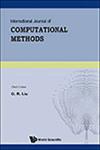A Moving Kriging Interpolation Meshless for Bending and Free Vibration Analysis of the Stiffened FGM Plates in Thermal Environment
IF 1.4
4区 工程技术
Q2 ENGINEERING, MULTIDISCIPLINARY
引用次数: 0
Abstract
This paper adopts the Moving Kriging (MK) interpolation meshless method to analyze the static and dynamic behaviors of stiffened functionally graded material (FGM) plate in thermal environment based on the physical neutral surface. The ribbed FGM plate is regarded as a composite structure of a FGM plate and ribs. The displacement transformation relationship between stiffeners and FGM plates is obtained through the displacement compatible conditions and MK interpolation. The meshfree model for ribbed FGM plate is obtained by superimposing the total energy of the FGM plate and the stiffeners based on the first-order shear deformation theory (FSDT) and physical neutral surface. The nonlinear temperature field along thickness direction is introduced into the meshless model of stiffened FGM plate. The equations governing the bending and free vibration of the ribbed FGM plate in thermal environment are obtained according to the principle of Minimum Potential Energy and Hamilton’s Principle. Thereafter, several ribbed FGM plate examples in different temperatures and with different locations of ribs are calculated. The results are compared with those given by the ABAQUS and literature. The results show that the effectiveness and accuracy of the proposed method in analyzing the ribbed FGM plate in thermal environment.热环境下FGM加筋板弯曲和自由振动分析的移动Kriging插值无网格法
基于物理中性面,采用无网格移动Kriging (MK)插值方法分析了加筋功能梯度材料(FGM)板在热环境下的静动态行为。肋形女性生殖器切割板被认为是女性生殖器切割板和肋骨的复合结构。通过位移相容条件和MK插值,得到了加强筋与FGM板之间的位移变换关系。基于一阶剪切变形理论(FSDT)和物理中性面,将FGM板和加劲筋的总能量叠加,得到了肋FGM板的无网格模型。在加筋FGM板无网格模型中引入沿厚度方向的非线性温度场。根据最小势能原理和哈密顿原理,得到了热环境下肋板弯曲和自由振动的控制方程。在此基础上,对不同温度和肋位置下的FGM肋板实例进行了计算。结果与ABAQUS和文献给出的结果进行了比较。结果表明,所提出的方法在热环境下对带肋FGM板进行分析的有效性和准确性。
本文章由计算机程序翻译,如有差异,请以英文原文为准。
求助全文
约1分钟内获得全文
求助全文
来源期刊

International Journal of Computational Methods
ENGINEERING, MULTIDISCIPLINARY-MATHEMATICS, INTERDISCIPLINARY APPLICATIONS
CiteScore
3.30
自引率
17.60%
发文量
84
审稿时长
15 months
期刊介绍:
The purpose of this journal is to provide a unique forum for the fast publication and rapid dissemination of original research results and innovative ideas on the state-of-the-art on computational methods. The methods should be innovative and of high scholarly, academic and practical value.
The journal is devoted to all aspects of modern computational methods including
mathematical formulations and theoretical investigations;
interpolations and approximation techniques;
error analysis techniques and algorithms;
fast algorithms and real-time computation;
multi-scale bridging algorithms;
adaptive analysis techniques and algorithms;
implementation, coding and parallelization issues;
novel and practical applications.
The articles can involve theory, algorithm, programming, coding, numerical simulation and/or novel application of computational techniques to problems in engineering, science, and other disciplines related to computations. Examples of fields covered by the journal are:
Computational mechanics for solids and structures,
Computational fluid dynamics,
Computational heat transfer,
Computational inverse problem,
Computational mathematics,
Computational meso/micro/nano mechanics,
Computational biology,
Computational penetration mechanics,
Meshfree methods,
Particle methods,
Molecular and Quantum methods,
Advanced Finite element methods,
Advanced Finite difference methods,
Advanced Finite volume methods,
High-performance computing techniques.
 求助内容:
求助内容: 应助结果提醒方式:
应助结果提醒方式:


